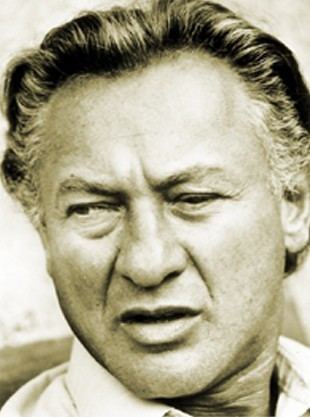Name Martin Gray Movies For Those I Loved | Role Author | |
 | ||
Similar People Max Gallo, Robert Enrico, Jacques Penot | ||
Martin Gray (born Mieczysław Grajewski; 27 April 1922 – 25 April 2016) was a Holocaust survivor who emigrated to the West, and published books in French about his purported experiences during World War II in which his family perished in Poland. Some have dismissed Gray's work as forgeries.
Contents
Life

Born in Warsaw, Second Polish Republic, Grajewski (Gray) was 17 years old when Nazi Germany and the Soviet Union invaded Poland. He wrote later that he escaped from the Treblinka extermination camp during the most deadly phase of the Holocaust. He joined the Red Army during the Soviet counter-offensive and became an officer of the NKVD secret police in August 1944. Grajewski (pseudonym "Zamojski") was tasked with breaking up Polish anti-communist underground in the area of Zambrów. By his own admission, Gray slept at the local NKVD headquarters with a pistol in his hand for security.
Grajewski emigrated in 1946 from Europe to the United States, where his grandmother was living. A decade after his arrival Gray had become a tradesman in replicas of antiques according to what he wrote, doing business in the U.S., Canada and Cuba. He moved to the South of France in 1960.
Gray moved to Belgium in 2001. On 25 April 2016, two days before his 94th birthday, he was found dead in his swimming pool at his home in Ciney, Belgium, where had lived since 2012.
Writings
Gray's first book, For Those I Loved (Au nom de tous les miens), became a bestseller. Another 11 books would follow over the years. All of Gray’s books have been written in French. Several of them have been translated into English. Gray’s last book Au nom de tous les hommes (2005) has not yet been translated into English.
Two of Gray’s books are autobiographies: the already mentioned For Those I Loved covers the era from his birth in 1922 to 1970, when Gray lost his wife and his four children in a forest fire. His second autobiography, La vie renaitra de la nuit, (Life Arises Out of Darkness) covers 1970-77, during which Gray found his second wife, Virginia. In this second autobiography he describes desperately looking for a way to live after the demise of his family in the 1970 fire. In 1979, U.S. photographer David Douglas Duncan produced a book of photographs and text about Gray: The Fragile Miracle of Martin Gray.
Criticism
Holocaust historian Gitta Sereny dismissed Gray's book as a forgery in a 1979 article in New Statesman magazine, writing that "Gray's For Those I Loved was the work of Max Gallo the ghostwriter: "During the research for a Sunday Times inquiry into Gray's work, M. Gallo informed me coolly that he 'needed' a long chapter on Treblinka because the book required something strong for pulling in readers. When I myself told Gray, the 'author', that he had manifestly never been to, nor escaped from Treblinka, he finally asked, despairingly, ‘But does it matter? Wasn't the only thing that Treblinka did happen, that it should be written about, and that some Jews should be shown to have been heroic?’" Pierre Vidal-Naquet, a French historian who first followed the idea of Gitta Sereny, has been persuaded by certificates provided by Martin Gray and withdrew his accusations against him. Nevertheless he continued to blame Max Gallo for taking liberties with the truth.
The Polish daily newspaper Nowiny Rzeszowskie (Rzeszów News) on 2 August 1990 published an interview with World War II Captain Wacław Kopisto, a soldier of the elite Polish Cichociemni unit, who took part in the raid on the Nazi German prison in Pińsk on 18 January 1943. Kopisto was shown the wartime photograph of Martin Gray (a.k.a. Mieczysław Grajewski) and said he had never seen Grajewski/Gray before in his life. Gray described his alleged participation in the same raid in his book For Those I Loved.
Kopisto stated, when asked about any Jewish person in his unit alluding to Gray, that among the sixteen Polish soldiers in his partisan group there was in fact a Polish Jew from Warsaw by the name of Zygmunt Sulima, his own long-term friend and colleague after the war. No man like the one in the photograph of Gray ever belonged to their unit; Kopisto said: "For the first time in my life I saw Martin Gray in a 1945 photo, which was published in March 1990 in Przekrój magazine (...) There were only sixteen of us participating in the 1943 Pińsk raid, and he was not among us."
